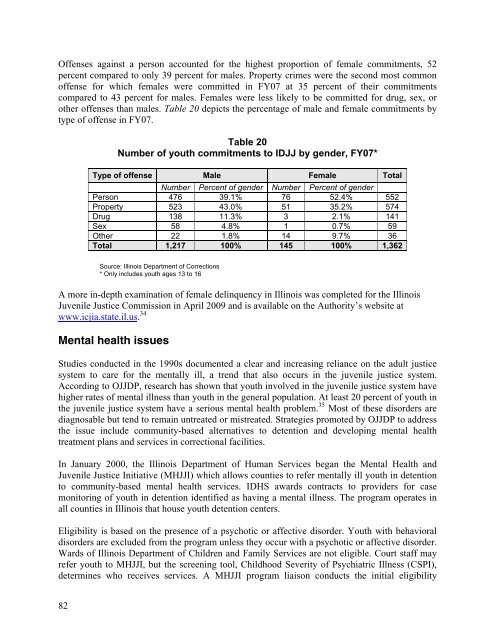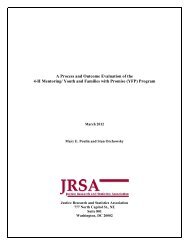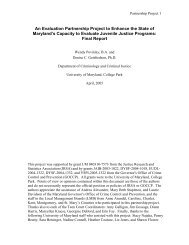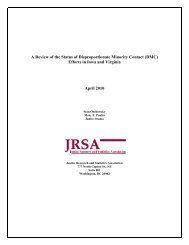Juvenile Justice System and Risk Factor Data - Illinois Criminal ...
Juvenile Justice System and Risk Factor Data - Illinois Criminal ...
Juvenile Justice System and Risk Factor Data - Illinois Criminal ...
You also want an ePaper? Increase the reach of your titles
YUMPU automatically turns print PDFs into web optimized ePapers that Google loves.
Offenses against a person accounted for the highest proportion of female commitments, 52<br />
percent compared to only 39 percent for males. Property crimes were the second most common<br />
offense for which females were committed in FY07 at 35 percent of their commitments<br />
compared to 43 percent for males. Females were less likely to be committed for drug, sex, or<br />
other offenses than males. Table 20 depicts the percentage of male <strong>and</strong> female commitments by<br />
type of offense in FY07.<br />
Table 20<br />
Number of youth commitments to IDJJ by gender, FY07*<br />
Type of offense Male Female Total<br />
Number Percent of gender Number Percent of gender<br />
Person 476 39.1% 76 52.4% 552<br />
Property 523 43.0% 51 35.2% 574<br />
Drug 138 11.3% 3 2.1% 141<br />
Sex 58 4.8% 1 0.7% 59<br />
Other 22 1.8% 14 9.7% 36<br />
Total 1,217 100% 145 100% 1,362<br />
Source: <strong>Illinois</strong> Department of Corrections<br />
* Only includes youth ages 13 to 16<br />
A more in-depth examination of female delinquency in <strong>Illinois</strong> was completed for the <strong>Illinois</strong><br />
<strong>Juvenile</strong> <strong>Justice</strong> Commission in April 2009 <strong>and</strong> is availa<br />
ble on the Aut hority’s website at<br />
www.icjia.state.il.us. 34<br />
Menta l health issues<br />
Studies conducted in the 1990s documented a clear <strong>and</strong> increasing reliance on the adult justice<br />
system to care for the mentally ill, a trend that als o occurs in the juvenile justice system.<br />
According to OJJDP, research has shown that youth involved in the juvenile justice system have<br />
higher rates of mental illness than youth in the general population. At least 20 percent of youth in<br />
the juvenile justice system have a serious mental health problem. 35 Most of these disorders are<br />
diagnosable but tend to remain untreated or mistreated. Strategies promoted by OJJDP to address<br />
the issue include community-based alternatives to detention <strong>and</strong> developing mental health<br />
treatment plans <strong>and</strong> services in correctional facilities.<br />
In January 2000, the <strong>Illinois</strong> Department of Human Services began the Mental Health <strong>and</strong><br />
<strong>Juvenile</strong> <strong>Justice</strong> Initiative (MHJJI) which allows counties to refer mentally ill youth in detention<br />
to community-based mental health services. IDHS awards contracts to providers for case<br />
monitoring of youth in detention identified as having a mental illness. The program operates in<br />
all counties in <strong>Illinois</strong> that house youth detention centers.<br />
Eligibility is based on the presence of a psychotic or affective disorder. Youth with behavioral<br />
disorders are excluded from the program unless they occur with a psychotic or affective disorder.<br />
Wards of <strong>Illinois</strong> Department of Children <strong>and</strong> Family Services are not eligible. Court staff may<br />
refer youth to MHJJI, but the screening tool, Childhood Severity of Psychiatric Illness (CSPI),<br />
determines who receives services. A MHJJI program liaison conducts the initial eligibility<br />
82

















